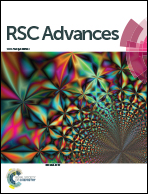Preparation and properties of a novel polymerizable amphiphilic anthraquinone derivative and its cationic colored copolymer latexes
Abstract
A novel polymerizable amphiphilic purple dye, 4-((4-(p-toluidino)anthraquinone-1-yl)oxy)-N-(2-(methacryloyloxy)ethyl)-N,N-dimethylbutan-1-aminium bromide (TAQMAB), was first designed and synthesized, and then used to prepare cationic covalently purple copolymer latexes through semi-continuous emulsion polymerization using water-soluble 2,2′-azobis(2-methylpropionamide) dihydrochloride (AIBA) as initiator. The chemical structure and properties of the dye were confirmed and characterized. Results showed that the critical micelle concentration and the hydrophilic lipophilic balance of TAQMAB were 975 mg L−1 and 32.8, respectively. The amphiphilic structure of TAQMAB gave the dye considerable water solubility and an ability to migrate from the monomer droplets into the latex particles during emulsion polymerization, which overcame the limitation of solubility, dye conversion, color depth of the latexes, and made the polymerization proceed smoothly. The total monomer conversion decreased gradually with dye amount increasing, while the dye still kept a relatively high conversion when an adequate amount of AIBA was used. Both the total monomer conversion and the dye conversion decreased with AIBA amount decreasing. The light fastness of the covalently colored film was significantly enhanced compared with the noncovalently colored one, which was ascribed to electrons flowing through the polymer chains.


 Please wait while we load your content...
Please wait while we load your content...